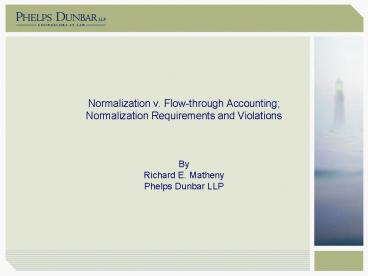Normalization v' Flowthrough Accounting Normalization Requirements and Violations - PowerPoint PPT Presentation
1 / 10
Title:
Normalization v' Flowthrough Accounting Normalization Requirements and Violations
Description:
... the investment tax credit and the alternative minimum ... A Brief History of Income Tax ... to the investment tax credit under IRC Section 38. ... – PowerPoint PPT presentation
Number of Views:333
Avg rating:3.0/5.0
Title: Normalization v' Flowthrough Accounting Normalization Requirements and Violations
1
Normalization v. Flow-through AccountingNormaliz
ation Requirements and Violations
- ByRichard E. MathenyPhelps Dunbar LLP
2
Normalization vs. Flow-through Accounting
- The debate over normalization versus flow-through
accounting for depreciation expense has been a
hot topic in ratemaking for public utilities
since Congress first authorized the use of
accelerated depreciation methods in 1954. The
issue is whether today's customers should pay
lower utility rates if the actual (current)
income tax expense of a public utility is lower
for a year because it uses accelerated rather
than straight line depreciation. The flip side of
this question is whether future years' customers
should pay higher utility rates when the
accelerated depreciation benefits reverse.
Normalization and flow- through are two possible
methods of accounting for dealing with this
issue.
3
Normalization
- Normalization is the interperiod allocation of
the income tax effects of accelerated
depreciation deductions, the investment tax
credit and the alternative minimum tax for
regulatory ratemaking purposes. "Normalization"
involves (1) setting up a deferred tax reserve
for the difference between depreciation expense
used by regulators to determine cost of service
(normally the straight line method) and the
accelerated method used for calculating tax
expense on income tax returns and then (2)
drawing down that reserve in later years as the
accelerated depreciation benefits reverse.
4
Flow-through
- Under a flow-through treatment, the income tax
effects of accelerated depreciation deductions,
the investment tax credit and the alternative
minimum tax are reflected in the utilitys cost
of service for rate-making purposes in the year
or years in which the tax effects are realized. - "Flow-through" uses actual (current) taxes
payable to establish cost of service in the
ratemaking process. Tax benefits such as
accelerated depreciation and investment tax
credits are applied dollar for dollar to reduce
income tax expense for ratemaking. The effect is
to reduce a utility's projected cost of service
and to lower utility rates.
5
A Brief History of Income Tax Normalization
- The IRS first promulgated normalization rules
with respect to the investment tax credit under
IRC Section 38. - Following the passage of the Revenue Act of
1962 several federal regulatory agencies mandated
the flow-through of the tax benefits of the ITC
to ratepayers. Congress imposed non-codified
rules on federal agencies restricting
flow-through because the purpose of the ITC was
to stimulate capital investment not to subsidize
the utility expenses of consumers. - The Tax Reform Act of 1969 extended
normalization requirements to the tax effects of
accelerated depreciation. Subsequent legislative
and regulatory developments have confirmed the
commitment to normalization of accelerated
depreciation.
6
Why Normalization?
- The flow-through method is a double whammy to the
fisc - the increased depreciation deduction reduces
corporate income taxes and, - corporate revenues are reduced in the initial
years since the income tax component of the cost
of service rates is lower. - Normalization protects revenues from the effects
of lower rates due to accelerated depreciation. - Congress has repeatedly said that the purpose of
accelerated depreciation is to encourage capital
investment at the corporate level not to lower
utility rates for consumers.
7
Normalization Requirements and Violations
- Subject to certain limited exceptions, public
utility property placed in service after 1986 is
depreciated under the MACRS rules ( Code Sec.
168). The normalization method of accounting
must be used for such property to qualify for
MACRS depreciation ( Code Sec. 168(f)(2) and Code
Sec. 168(i)(9)).
8
168(i)(9) NORMALIZATION RULES
- 168(i)(9)(A) IN GENERAL. --In order to use a
normalization method of accounting with respect
to any public utility property for purposes of
subsection (f)(2) -- - 168(i)(9)(A)(i) the taxpayer must, in computing
its tax expense for purposes of establishing its
cost of service for ratemaking purposes and
reflecting operating results in its regulated
books of account, use a method of depreciation
with respect to such property that is the same
as, and a depreciation period for such property
that is no shorter than, the method and period
used to compute its depreciation expense for such
purposes and - 168(i)(9)(A)(ii) if the amount allowable as a
deduction under this section with respect to such
property differs from the amount that would be
allowable as a deduction under section 167 using
the method (including the period, first and last
year convention, and salvage value) used to
compute regulated tax expense under clause (i),
the taxpayer must make adjustments to a reserve
to reflect the deferral of taxes resulting from
such difference.
9
Basic Normalization Rules
- A taxpayer is considered to use a normalization
method of accounting if - It uses the same depreciation method in computing
ratemaking tax expense as is used for purposes of
determining depreciation expense for cost of
service, and, - Any difference in tax attributable to the use of
a method for ratemaking purpose different from
the method use for federal income tax purposes is
credited or debited to a reserve account. - The reserve for deferred taxes attributable to
normalization may be treated as a reduction from
the rate base or a zero-cost capital for
rate-making purposes.
10
The Penalty for Failure to Normalize
- Failure to normalize causes the loss of
accelerated depreciation deductions with respect
to the taxpayers public utility property. - Other Normalization Issues
- Normalization of investment tax credits
- Normalization of alternative minimum tax
- Normalization of excess deferred tax reserves
- FERC normalization requirements































